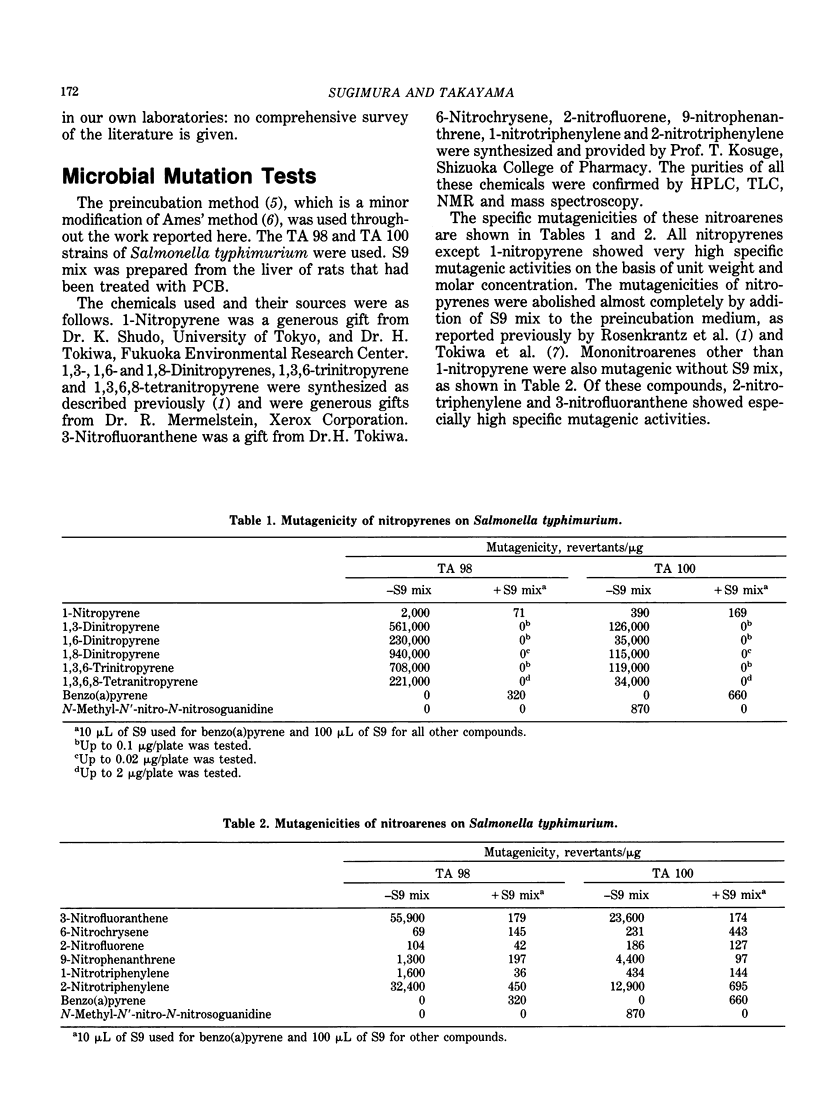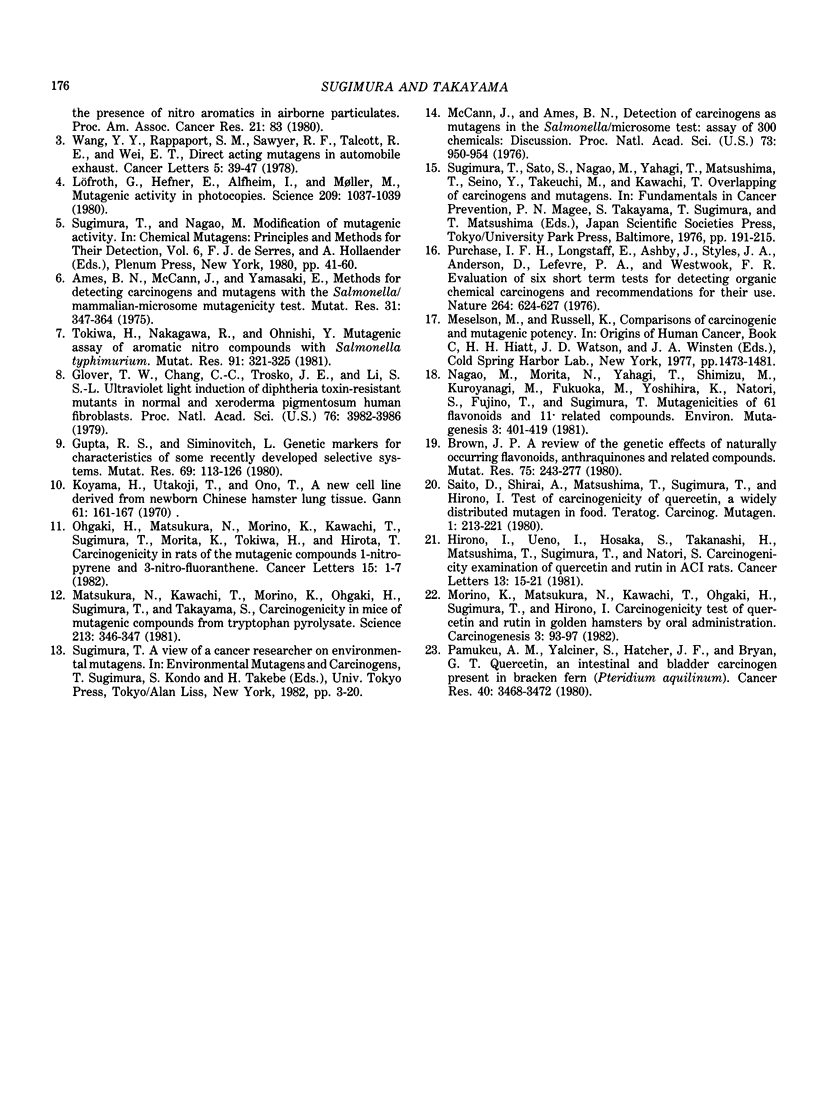Abstract
Pure synthetic nitropyrene compounds were subjected to a mutation test using Salmonella typhimurium TA 98 and TA 100 with and without S9 mix, a metabolic activation system. Dinitropyrenes were highly mutagenic. Among them, 1,8-dinitropyrene was the most potent mutagen, producing 940,000 revertants of TA 98/micrograms. 1,3,6-Trinitropyrene and 1,3,6,8-tetranitropyrene were also highly mutagenic, producing 708,000 and 221,000 revertants/micrograms, respectively. 1-Nitropyrene was weakly mutagenic. All nitropyrenes were more mutagenic towards TA 98 than TA 100, and all mutagenic activities were abolished by the presence of S9 mix. Di- and trinitropyrenes were demonstrated to be mutagenic to Chinese hamster lung cells without metabolic activation, by using diphtheria toxin resistancy as a marker. The range of mutagenic potential of nitropyrenes was much narrower with cultured mammalian cells than with Salmonella. 1-Nitropyrene was not mutagenic. 1,6-Dinitropyrene and 1-nitropyrene induced unscheduled DNA synthesis in epithelial cells of in vitro cultured human bronchi, as did diol-epoxides of benzo[a]pyrene, while benzo[a]pyrene itself was inert. 1-Nitropyrene and 3-nitrofluoranthene produced subcutaneous fibrosarcomas at the loci of injections in the backs of rats. Tumors were found in 47% and 40% of animals with total doses of 40 mg of 1-nitropyrene and 30 mg of 3-nitrofluoranthene, respectively. The biomedical significance of nitroarenes is discussed.
Full text
PDF





Selected References
These references are in PubMed. This may not be the complete list of references from this article.
- Ames B. N., Mccann J., Yamasaki E. Methods for detecting carcinogens and mutagens with the Salmonella/mammalian-microsome mutagenicity test. Mutat Res. 1975 Dec;31(6):347–364. doi: 10.1016/0165-1161(75)90046-1. [DOI] [PubMed] [Google Scholar]
- Brown J. P. A review of the genetic effects of naturally occurring flavonoids, anthraquinones and related compounds. Mutat Res. 1980 May;75(3):243–277. doi: 10.1016/0165-1110(80)90029-9. [DOI] [PubMed] [Google Scholar]
- Glover T. W., Chang C. C., Trosko J. E., Li S. S. Ultraviolet light induction of diphtheria toxin-resistant mutants of normal and xeroderma pigmentosum human fibroblasts. Proc Natl Acad Sci U S A. 1979 Aug;76(8):3982–3986. doi: 10.1073/pnas.76.8.3982. [DOI] [PMC free article] [PubMed] [Google Scholar]
- Gupta R. S., Siminovitch L. Genetic markers for quantitative mutagenesis studies in Chinese hamster ovary cells: characteristics of some recently developed selective systems. Mutat Res. 1980 Jan;69(1):113–126. doi: 10.1016/0027-5107(80)90181-5. [DOI] [PubMed] [Google Scholar]
- Hirono I., Ueno I., Hosaka S., Takanashi H., Matsushima T., Sugimura T., Natori S. Carcinogenicity examination of quercetin and rutin in ACI rats. Cancer Lett. 1981 Jun;13(1):15–21. doi: 10.1016/0304-3835(81)90081-1. [DOI] [PubMed] [Google Scholar]
- Koyama H., Utakoji T., Ono T. A new cell line derived from newborn Chinese hamster lung tissue. Gan. 1970 Apr;61(2):161–167. [PubMed] [Google Scholar]
- Löfroth G., Hefner E., Alfheim I., Møoller M. Mutagenic activity in photocopies. Science. 1980 Aug 29;209(4460):1037–1039. doi: 10.1126/science.6996094. [DOI] [PubMed] [Google Scholar]
- Matsukura N., Kawachi T., Morino K., Ohgaki H., Sugimura T., Takayama S. Carcinogenicity in mice of mutagenic compounds from a tryptophan pyrolyzate. Science. 1981 Jul 17;213(4505):346–347. doi: 10.1126/science.7244619. [DOI] [PubMed] [Google Scholar]
- McCann J., Ames B. N. Detection of carcinogens as mutagens in the Salmonella/microsome test: assay of 300 chemicals: discussion. Proc Natl Acad Sci U S A. 1976 Mar;73(3):950–954. doi: 10.1073/pnas.73.3.950. [DOI] [PMC free article] [PubMed] [Google Scholar]
- Morino K., Matsukara N., Kawachi T., Ohgaki H., Sugimura T., Hirono I. Carcinogenicity test of quercetin and rutin in golden hamsters by oral administration. Carcinogenesis. 1982;3(1):93–97. doi: 10.1093/carcin/3.1.93. [DOI] [PubMed] [Google Scholar]
- Nagao M., Morita N., Yahagi T., Shimizu M., Kuroyanagi M., Fukuoka M., Yoshihira K., Natori S., Fujino T., Sugimura T. Mutagenicities of 61 flavonoids and 11 related compounds. Environ Mutagen. 1981;3(4):401–419. doi: 10.1002/em.2860030402. [DOI] [PubMed] [Google Scholar]
- Pamukcu A. M., Yalçiner S., Hatcher J. F., Bryan G. T. Quercetin, a rat intestinal and bladder carcinogen present in bracken fern (Pteridium aquilinum). Cancer Res. 1980 Oct;40(10):3468–3472. [PubMed] [Google Scholar]
- Purchase I. F., Longstaff E., Ashby J., Styles J. A., Anderson D., Lefevre P. A., Westwood F. R. Evaluation of six short term tests for detecting organic chemical carcinogens and recommendations for their use. Nature. 1976 Dec 16;264(5587):624–627. doi: 10.1038/264624a0. [DOI] [PubMed] [Google Scholar]
- Rosenkranz H. S., McCoy E. C., Sanders D. R., Butler M., Kiriazides D. K., Mermelstein R. Nitropyrenes: isolation, identificaton, and reduction of mutagenic impurities in carbon black and toners. Science. 1980 Aug 29;209(4460):1039–1043. doi: 10.1126/science.6996095. [DOI] [PubMed] [Google Scholar]
- Saito D., Shirai A., Matsushima T., Sugimura T., Hirono I. Test of carcinogenicity of quercetin, a widely distributed mutagen in food. Teratog Carcinog Mutagen. 1980;1(2):213–221. doi: 10.1002/tcm.1770010209. [DOI] [PubMed] [Google Scholar]
- Tokiwa H., Nakagawa R., Ohnishi Y. Mutagenic assay of aromatic nitro compounds with Salmonella typhimurium. Mutat Res. 1981 Jul-Sep;91(4-5):321–325. doi: 10.1016/0165-7992(81)90008-7. [DOI] [PubMed] [Google Scholar]
- Wang Y. Y., Rappaport S. M., Sawyer R. F., Talcott R. E., Wei E. T. Direct-acting mutagens in automobile exhaust. Cancer Lett. 1978 Jul;5(1):39–47. doi: 10.1016/s0304-3835(78)80009-3. [DOI] [PubMed] [Google Scholar]


